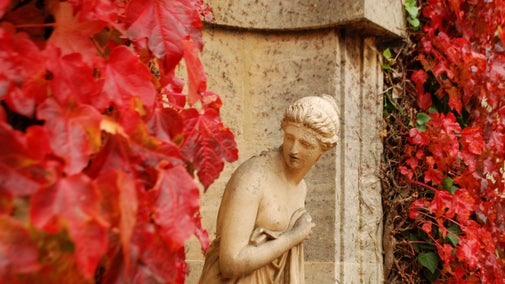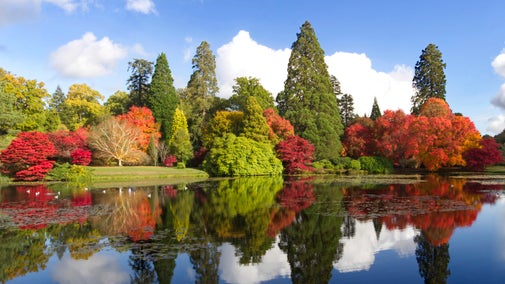
Discover more at Belton
Find out everything you need to know about visiting Belton, including how to get here, things to see and do on your visit, and more.

Belton was designed to impress, and the garden reflects late seventeenth-century formality in keeping with the period of the mansion. Whatever time of year you visit, the shifting seasons provide a great variety of colour and wildlife to see.
The gardens will close at 3pm on Christmas at Belton illuminated trail event dates, between 22 November - 1 January 2025. This is to allow the team to prepare the light trail for the evening, thank you for your understanding.
Inspired by the 1st Earl’s Grand Tour of Italy, Sir Jeffry Wyatville was commissioned to design this sunken garden in the early nineteenth century. Successive Brownlow generations enhanced and enriched its plants and sculptures.
Before the First World War, Belton would have drawn on the services of some 30 gardeners, but country houses went into decline in the inter-war period and the Brownlow family significantly reduced the number of gardeners to allow for their changing financial priorities.
Over time the Italian Garden lost many of its important features. Belton’s garden team have worked from historic plans, photos and paintings to recreate the deep herbaceous borders running through the centre of the Italian Garden.
Due to our rapidly changing climate, we have decided to move away from seasonal planting schemes and move towards perennial planting in our beds. In the long-run, this will help us save water and resources, helping to future-proof the gardens. Historically, there were metal arches supporting climbing plants all the way around the fountain. To pay homage to this, we have started re-introducing the use of arches and obelisks in the Italian Garden.
The borders add colour and interest over the summer months. Colour remains in the Italian garden until late October with seasonal borders and the rich autumn hues of Crataegus prunifolia trees. Winter is heralded with the appearance of berries on the garden’s yew topiary.

Overlooking the Italian Garden, this protective environment is home to a collection of lush foliage and exotic blooms. Californian and Kentia Palms add texture and height. Pelargoniums frame a tranquil pool, serenely overlooked by Belton’s bather statue.
Designed by Jeffry Wyatville in 1810 and built in 1820, Belton’s Conservatory was crafted around a cast-iron sub-frame, making it the first garden building of its type in England.
In the walled garden behind the Conservatory fragrant roses are a delight in the summer months.
The twelfth-century parish church of St Peter and St Paul, beside the Conservatory, is well worth a visit and belongs to the Lincoln Diocese.
The 3rd Earl commissioned the Dutch Garden in the late nineteenth century. The garden takes its name from the layout of the colourful parterres divided by topiary-lined gravel paths and was inspired by Dutch design.
One of Belton’s most popular views is from the sundial, looking back at the honey-coloured stone of the house and north terrace steps. This view featured as Lady Catherine de Burgh’s home, Rosings, in the 1995 BBC TV series of Pride and Prejudice, starring Colin Firth and Jennifer Ehle.
Belton’s sundial was created by Caius Gabriel Cibber, a renowned sculptor of the period who also worked on St Paul’s Cathedral and Hampton Court Palace for Sir Christopher Wren. It was placed in the Dutch Garden by Sir John Brownlow some time between 1721 and 1754. Carved from limestone, the pedestal of the sundial shows Cronus, god of time and Eros, god of love.
The sundial is also a focus of nostalgia for lovers of Helen Creswell’s 1980’s book ‘Moondial’ and the BBC television drama that followed. The series, which tells the story of a young girl who discovers that the ‘moondial’ is in fact a portal to the past, was filmed almost entirely at Belton House.

Take a stroll along the Statue Walk to the generously sized oak bench inspired by an original design from the 1890s. There's plenty of room for groups and families to sit together for a photo opportunity.
Enjoy wonderful views over open parkland. Delight in the rustic glory of the East Avenue with its magnificent horse chestnut and lime trees. You might catch a fleeting glimpse of a majestic buck with a full set of antlers and gleaming coat. Listen out for the husky bark of a buck trying to catch the attention of the female does.
Enjoy the superb views of Bellmount Tower, then meander along winding wooded paths to the tranquil lakeshore. The fishing lodge makes a picture-perfect photo location, and on sunny days is a superb place for bird watching.
Head back towards the house along sheltered paths via the Mirror Pond and a variety of specimen trees including a weeping beech, a twisted willow, and magnificent cedars.

Find out everything you need to know about visiting Belton, including how to get here, things to see and do on your visit, and more.

Belton is a three pawprint rated place and offers plenty of opportunities for bounding, jumping and sniffing for dogs. With 1,300 acres to explore, come and join us for a wander with your four-legged friend.

Explore 1,300 acres of parkland at Belton and find out more about the wildlife you may see along the way, including the herd of historic fallow deer.

Packed full of treasures, discover a mansion bursting with history. Belton's collection tells a story rich in global history and our future work will focus on bringing those stories to life.

Rest and refuel in a historic setting or treat yourself to something special to take home. Find out about our dog-friendly café and other places to eat and shop.

Explore our fun family day out ideas, including our indoor play area and outdoor adventure playground. Make the most of your day out with the kids at Belton this October Half Term.

From 18th-century water gardens and Arts and Crafts landscapes to intimate woodland gardens, there are so many places to discover.

Discover our gardeners’ top tips so you can make the most of your garden, plot or window box.

Discover the historic gardens, parkland and historic pleasure grounds around Nottinghamshire and Lincolnshire, which are perfect for relaxing in and reconnecting with nature.